Science Highlights, April 1, 2015
Awards and Recognition
Earth and Environmental Sciences
Opportunities and challenges for supercritical CO2 as a fracturing fluid
Materials Physics and Applications
Computational and experimental approaches examine tuning of magnetic materials
Materials Science and Technology
Discovery of surprisingly mobile defects in face-centered cubic metals
Science on the Roadmap to MaRIE
Neutron surface scattering studies important aspects of actinide surface chemistry
Awards and Recognition
George “Rusty” Gray’s accomplishments recognized at TMS honorary symposium
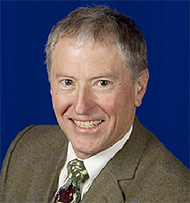
Rusty Gray (Materials Science in Radiation and Dynamics Extremes, MST-8) was honored with a six-session symposium during TMS 2015, The Minerals, Metals & Materials Society’s (TMS) 144th annual meeting and exhibition, held in March in Orlando, Florida.
Gray, who has a PhD in metallurgical engineering from Carnegie Mellon University, joined the Laboratory in 1985. He pursues fundamental and applied research primarily in the elucidation of the structure and property behavior of materials subjected to dynamic and shock-wave deformation.
The “Constitutive Response and Modeling of Structural Materials” symposium, in honor of Gray’s 60th birthday, was a forum for discussing recent investigations concerning structure/property relations within structural materials – the heart of Gray’s work. Primary focus areas included constitutive response/modeling of structural materials, characterization of microstructural, textural, and damage evolution; prediction and simulation of strength and damage evolution; and model validation and experimental support.
Ellen Cerreta (MST-8), Eric Brown (Neutron Science and Technology, P-23), Neil Bourne (University of Manchester, United Kingdom), James Williams (The Ohio State University), and Kenneth Vecchio (University of California – San Diego) organized the symposium, with sponsorship from the TMS Structural Materials Division and the Mechanical Behavior of Materials Committee.
As the 2010 TMS president, Gray broadened the society’s international reach through conferences with the Brazilian Metallurgical Society and the Canadian Metallurgical Society, helped organize an Energy Materials Blue Ribbon panel to explore how advances in materials science and engineering could contribute to an energy-efficient and low-carbon economy, and spearheaded a study on volunteerism, one of his personal passions. He has served on TMS programming, titanium, and mechanical behavior committees, and on its board of directors as Structural Materials Division chair and director of publications; and has received the Structural Materials Division’s Distinguished Scientist/Engineer Award. He is a Fellow of TMS, Los Alamos National Laboratory, the American Physical Society, and ASM International.
The TMS encompasses the entire range of materials and engineering, from minerals processing and primary metals production to basic research and the advanced applications of materials. The annual meeting draws more than 4,000 business leaders, engineers, scientists, and other professionals in the materials field for an exchange of technical knowledge leading to solutions in the workplace and in society. Technical contact: Rusty Gray
Gia-Wei Chern and Xuedan Ma receive Postdoc Distinguished Performance Awards
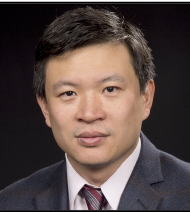
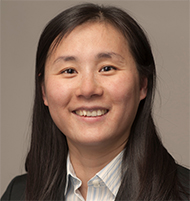
The Laboratory honored Gia-Wei Chern and Xuedan Ma with Distinguished Postdoc Distinguished Performance Awards. The awards recognize individuals or teams of no more than three who were major contributors towards outstanding and unique research resulting in a positive, significant impact on the Laboratory’s programmatic efforts, or status in the scientific community. Technical contact: Mary Anne With
Gia-Wei Chern, (Physics of Condensed Matter and Complex Systems/Center for Nonlinear Studies, T-4/T-CNLS), a J. Robert Oppenheimer Distinguished Postdoctoral Fellow, is recognized for his outstanding research and leadership in condensed matter physics and statistical mechanics. Chern has made seminal contributions to highly frustrated many-body systems, with applications in condensed matter, atomic, and statistical physics. These contributions include the discovery of novel magnetic orderings in frustrated itinerant magnets, the derivation of the concept of stiffness by disorder in statistical physics, and the design of new artificial spin ice systems with subtle emergent behavior that a Nature commentary calls “a first step into an uncharted territory”. Chern is leading the first attempt to add electronic correlations to tight-binding molecular dynamics, an innovative and promising method for modeling the lattice dynamics of strongly correlated materials, such as lanthanides and actinides. He is a prolific author of papers in top quality journals, leading theoretical proposals that have produced high impact in the community by prompting new experimental advances. During 2014, Chern published one article in Nature, two articles in Nature Physics, and three articles in Physical Review Letters. Cristian Batista (T-4) nominated him.
Xuedan Ma (Center for Integrated Nanotechnologies, MPA-CINT) is recognized for her groundbreaking contributions to the study of solitary oxygen dopant states in carbon nanotubes. Intentional incorporation of impurities and defects serves as a powerful tool to enable new materials functionality. Ma performed the first low temperature photoluminescence studies on individual oxygen-doped carbon nanotubes. This brought a deeper understanding of the electronic structure and chemical nature of these dopant states. Ma discovered a new solid-state approach for controlled incorporation of these dopant states. While the dopant states created via conventional solution chemistry exhibit photoluminescence fluctuation and bleaching, the states achieved via her solid-state approach can emit fluctuation-free photoluminescence emission over hours of continuous laser excitation. Ma performed the first quantum optical experiments on these ultra-stable dopant states and demonstrated room temperature single photon generation from them, which had been considered to be impossible for 1-dimensional carbon nanotubes. This discovery could start a new branch of study in the area of solitary dopant quantum optics and reinvigorate efforts on development of carbon nanotubes-based quantum light sources. The impact of her work spans from fundamental photophysics of carbon nanotubes to optoelectronic and quantum information processing technologies. Her research has led to three papers: ACS Nano (published), Nature Nanotechnology (under review), and Nano Letters (submitted). She published another ACS Nano paper as the first author and has aT. Leitner, S. Tretiak, and B. Uberuaga win Postdoc Distinguished Mentor Awards

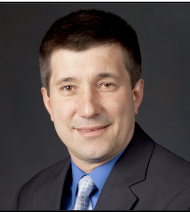
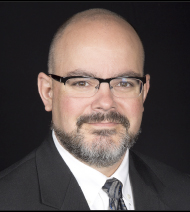
Postdoc Distinguished Mentor Awards recognize the positive impact and contributions that a mentor makes during a postdoc’s appointment and who demonstrate a level of mentoring substantially beyond expectations. Technical contact: Mary Anne With
Thomas Leitner (Theoretical Biology and Biophysics, T-6) demonstrates his exceptional dedication, willingness, and ability to foster the intellectual development of his postdocs and support their growth into independent scientists. He is a great role model for his mentees due to his scientific integrity, intellectual curiosity, and open-mindedness to new ideas and approaches. Leitner gives his postdocs the freedom to pursue and develop their varied research interests while providing insightful feedback and ensuring that the projects stay on track. He treats his mentees as valued and respected colleagues, genuinely cares for their well-being, and is sensitive to their individual needs. Leitner encourages open discussion about research progress and direction and the importance of maintaining a healthy work-life balance. He provides postdocs opportunities to attend international conferences, mentor students, and to pursue international collaborations. Leitner encourages his postdocs to take an active role in all aspects of grant writing, which is critical in becoming an independent scientist. He aids the career aspirations of his postdocs, initiating conversations about their future plans and making it clear that he will do everything that he can to help them along the way. Having recently acquired the necessary funding for the conversion into staff of one of his postdocs, Leitner is pursuing other funding opportunities to increase the flexibility of future career prospects for his other postdocs. His postdocs hold him in the highest of regards and feel fortunate to have him as a mentor. Quoting one of his postdocs, “Any future success I find in science, I will owe, in large part, to Thomas.”
Postdoc Research Associate Taina Immonen (T-6) nominated Leitner.
Sergei Tretiak (Physics and Chemistry of Materials, T-1) was nominated for his mentorship in advanced research pursuits, insightful guidance, and dedication to education and training the new generation of scientists. In less than 15 years as a LANL staff member, Tretiak has hosted nearly 50 students, and he has mentored 11 postdocs from diverse backgrounds in addition to the 5 postdocs he currently mentors. Nearly all of his past postdocs have become either technical staff in national labs or entered faculty positions in academia. This outcome demonstrates his dedication to prepare his postdocs for future positions. Tretiak’s influence extends beyond his postdoc’s time at LANL: most of his past postdocs are continued collaborators, and many of their students visit LANL and work with him.
Tretiak has a unique ability to adapt his mentoring style to meet individual needs.Tretiaks’s investment with his postdocs goes beyond research and writing publications. He encourages postdocs to gain exposure within the larger scientific community by giving seminars, attending conferences, hosting Lab visitors, and developing collaborations. Tretiak stimulates the growth of leadership skills by encouraging his postdocs to co-advise summer students. Postdocs have an opportunity to propose an idea and be responsible for training a student and for the successful outcome of the project. His postdocs hold Tretiak in the highest regard for his support and mentorship. He consistently demonstrates an ability to increase the their scientific abilities, exposure, and career opportunities. One of his postdocs stated, “He has truly mastered the very difficult balance of being hands off enough for his protégés to teach themselves what they need to know and make their own mark on their research while being involved enough to know exactly when to step in and prevent an extended period of time in the ‘wilderness of research’. ”
Seven current or former postdocs, all of T-1 and/or the Center for Nonlinear Science, nominated Tretiak. Current postdocs include Feynman Fellow Tammie Nelson, current Postdoc Research Associates Amanda Neukirch, Lyudmyla Adamska, and Josiah Bjorgaard; former postdoc Hao Li, and faculty members Svetlana Kilina and Andriy Zhugayevych.
Blas Pedro Uberuaga (Materials Science in Radiation and Dynamics Extremes, MST-8) currently mentors 6 postdocs, and has successfully mentored 13 postdocs in the past at LANL. Five of his past postdocs are technical staff in industry, two have been converted as scientific staff at LANL, two have joined other laboratories, and three have taken academic positions. Uberuaga is a very dedicated mentor who improves his postdocs’ career portfolio and motivates them to become successful researchers. He accommodates, inspires, and trains culturally diverse postdocs with variety of abilities and interests, and mentors them to pursue successful careers. Uberuaga shows a keen interest in future goals of postdocs and acts as a career guide, offering a vision and tailoring support to each. As an experienced leader for several projects, he shares the importance of effective communications in scientific paper writing, technical presentations, and proposal writing. Uberuaga is very organized and meets regularly with his postdocs. He encourages them to think independently and establish new collaborations to gain visibility in the field. Uberuaga provides postdocs with great freedom and encourages them to try new ideas that could lead to novel discoveries. When projects are successful, he displays remarkable humility and gives the credit to postdocs. This helps postdocs develop leadership abilities and gain visibility in scientific circles. Uberuaga is determined to leave a legacy of how to be a good mentor through role modeling and instituting policies that set high expectations and standards for mentorship. He is a world-renowned materials scientist, but that persona pales in comparison to the generous, thoughtful, dedicated mentor he is to postdocs. Current MST-8 postdocs Pratik Dholabhai, Ghanshyam Pilania, and Satyesh Yadav nominated him.
Bioscience
Developing a novel means to detect traumatic brain injury
A LANL technology developed for detecting tuberculosis is being adapted as a diagnostic for traumatic brain injury. The work is conducted in conjunction with Samitaur Medical Technologies, which recently signed a cooperative research and development agreement (CRADA) with the Laboratory for this purpose. The ultimate goal of this project is to not only detect traumatic brain injury, but eventually to guide treatment as well.
Traumatic brain injury typically results from a blow to the head. It afflicts a significant percentage of US troops deployed in Iraq and Afghanistan, and has been named the “signature disease” of recent wars. Players in sports such as football or soccer also frequently experience some level of brain injury. Currently, questionnaires are used to diagnose this condition, which can range from mild concussion to severe brain damage. A more quantitative diagnostic is needed urgently.
A promising approach for solving the traumatic brain injury diagnostic conundrum is to seek unique biomarkers that are produced after a brain injury. In medicine, biomarkers are traceable substances that occur in an organism and indicate something about its function or health. Biomarkers can be challenging to detect, and the Samitaur-LANL research team is tackling the task of characterizing the small, immediate changes that occur in a human body during mild to severe brain injury. The work requires characterizing brain biomarkers in both normal and injured patients.

The research team consists of Samitaur Medical Technologies staff and LANL scientists from Bioscience (B), Chemistry (C), Physics (P), and Theoretical (T) divisions. Frederick and Laurie Samitaur Smith founded Samitur. The company has a vision of working with the national laboratories to address needs in the medical community and has recognized that LANL technologies such as the waveguide biosensor might be applied to traumatic brain injury. Samitaur’s chief medical officer, Dr. Donald Becker, has pioneered the establishment of Head Trauma Centers in the US and beyond. He is a former Chief of Neurosurgery at the University of California – Los Angeles and an internationally recognized expert on traumatic brain injury.
The multi-disciplinary LANL technical team brings together expertise in mass spectrometry, optical waveguide biosensor detection, biomarker discovery, and data correlation methods to analyze cerebrospinal fluid from both normal and traumatic brain injury patients. The researchers have experience in working with complex challenges such as this, and in transitioning laboratory-based development to real-world applications.
The work supports the Lab’s Global Security mission area and the Science of Signatures science pillar through the development of sensors for injury. Technical contacts: Dung Vu and Harshini Mukundan
Chemistry
A new approach to trap atoms and molecules
Los Alamos researchers have demonstrated the feasibility of a new approach to the experimental technique of trapping cold atoms and molecules. Accumulator rings (i.e. storage rings and synchrotrons in the injection phase) are essential tools of high-energy physics (HEP) that build phase-space density in particle bunches by charge-exchange injection. The proton storage ring at the Los Alamos Neutron Science Center (LANSCE) is an example. However, accumulator principles are not exclusive to high-energy physics. The team found that accumulators may also be formed for the low-energy particles represented by laser-cooled neutral atoms and molecules. Excursions into low-temperature quantum chemistry could be enabled with an accumulator that gathers a variety of laser-cooled particles and causes them to collide with one another.
An accumulator uses a non-Hamiltonian process to build phase-space density. This circumvents Liouville’s theorem, which states that phase-space density is preserved in processes governed by Hamilton’s equations. In the case of high-energy physics accumulator rings, the injected particles have one charge state, while the stored particles have another charge state. At LANSCE, negatively charge hydrogen atoms (protons cloaked in two electrons) are injected into the proton storage ring and pass through a stripper foil to remove the two electrons. The resultant bare protons join the protons already stored. Protons accumulate until a maximum number is reached against losses caused by space-charge forces, instabilities, etc. The non-Hamiltonian process is the change of the charge of the particles in the stripper foil.
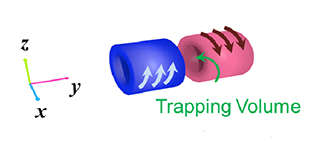
Figure 1. Solenoid arrangement for a cusp field.
In the context of laser-cooled neutral atoms and molecules, the analogous non-Hamiltonian process is the change of quantum state the particles undergo during optical pumping. The accumulator need only be a simple magneto-static trap, appropriate for holding the great majority of laser-cooled particles, because they are paramagnetic. Figure 1 shows a standard magnetic trap called a cusp solenoid that is suitable for these purposes. The arrows wrapping each cylinder depict the flow of electrical current. A cusp field could also be constructed from ring magnets.
Figure 2 depicts the variation of the axial magnetic field, |B|, by the solid line. In traps with a central minimum in |B|, like those depicted in Figures 1 and 2, the stored particles are in a field-repelled Zeeman state, pushed away by |B| and oscillating about its minimum. Laser-cooled particles would likely approach the trap in the same field-repelled state. Between approach and storage must come the non-Hamiltonian process of optical pumping that changes the particle to a different state for injection. Through evidence in the literature and the team’s own calculations, it appears that optical pumping can switch field-repelled particles quickly to their quantum opposite of a field-seeking Zeeman state. This sets the stage for an accumulator.
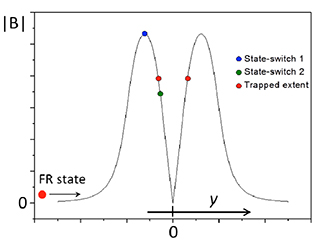
Figure 2. Axial variation of the cusp field (solid curve), and accumular concept by state switching. FR is field-repelled.
As indicated in Figure 2, a field-repelled particle (red dot) approaches the trap and climbs to the top of the confining potential with a finite velocity. There, it is switched (blue dot) to field-seeking. Because the switch does not change the velocity, the particle proceeds into the trap and continues to lose momentum. Now in the field-seeking state, the particle sees the decreasing field as a potential hill to climb. Before it comes to a halt, the particle is switched back (green dot) to field-repelled for storage. The process repeats, building the trapped number and density. The two red dots within the trap bracket the turning points of oscillation. A simple consideration of potential and kinetic energies shows that the trapped particles are cooler than those injected.
Beyond these notional considerations, the researchers subjected the accumulator concept to the scrutiny of a sophisticated particle-tracking code drawn from the Laboratory’s work spanning high-energy physics to the storage of ultracold neutrons. Figure 3 depicts the computed trajectory of a lithium atom injected into and trapped within a cusp-field accumulator fashioned from permanent magnets. The trajectory is colored red where the atom is in the field-repelled state and heading toward the trap, green when in the field-seeking state, and blue when returned to the field-repelled state for trapping. The loops of the blue-colored trajectory show the atom to be trapped near the field minimum. The models indicate that the cusp-field configuration offers a high acceptance of laser-cooled particles. Once inside the trap, the particles could be further cooled and made denser in phase space through known processes that dissipate kinetic energy. If proven, this accumulator concept could enable experiments in cold-particle quantum physics and chemistry that are outside the reach of current methods.

Figure 3. Trajectory of a lithium atom injected into the accumulator and subsequently trapped in stable orbits.
Earth and Environmental Sciences
Opportunities and challenges for supercritical CO2 as a fracturing fluid
Hydraulic fracturing of shale formations in the United States has led to a domestic energy boom. The process of injecting a fluid – typically water – into a target formation at pressures high enough to fracture the rock, is performed to increase permeability and thereby increase production. Currently, water is the only fracturing fluid regularly used in large-scale commercial shale oil and gas production in the U.S. Industry and researchers are interested in non-aqueous working fluids due to their potential to increase production, reduce water requirements, and to minimize environmental impacts. Theoretically, widespread use of non-aqueous working fluids could have a transformative impact on the U.S. energy industry and energy security. However, the science behind non-aqueous fracturing fluids is still relatively immature. Researchers in LANL’s Earth and Environmental (EES) Division have published a paper in Applied Energy examining opportunities and challenges to producing gas from tight shale formations (Figure 4).
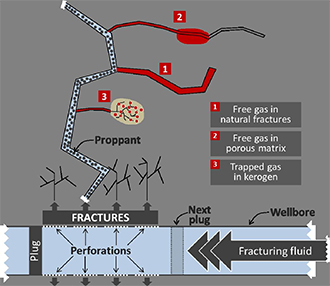
Figure 4. Schematic of a fracturing system highlighting induced and natural fractures and three primary gas-in-place origins of methane. The length scales involved in shale gas production cover thirteen orders of magnitude, ranging from nanometer size pores where methane is trapped, and sometimes up to kilometer long fractures that are conduits to the production well. An alternative fracturing fluid such as supercritical carbon dioxide (CO2) may more efficiently extract gas from (1) and (2) because CO2 is miscible with hydrocarbon, thereby preventing multi-phase flow blocking, and from (3) because CO2 can exchange with methane that is sorbed to kerogen (insoluble organic material).
The very small permeability of these formations prohibits efficient extraction using conventional methods. In addition, concerns about the use of water (e.g. water-availability, treatment or disposal of contaminated flow-back water, and induced seismicity) have encouraged increased exploration into the use of non-aqueous fracturing fluids such as supercritical CO2. Therefore, the Los Alamos researchers used a combination of new experimental (Figure 5) and modeling (Figure 6) data at multiple scales to analyze the benefits and drawbacks of using supercritical CO2 as a working fluid for shale gas production.
To evaluate the contribution of fundamental mechanisms to shale gas production, the team performed simulations using a novel reservoir-scale discrete fracture network (DFN) modeling approach that LANL developed, in which reservoir fractures are modeled as a set of two-dimensional planes in three-dimensional space with specified shape, orientation, aperture, and permeability. The subsurface flow simulator PFLOTRAN, a massively parallel code, calculated the pressure solution in the network. Particles representing gas packets are uniformly distributed throughout the network, and their travel time to the well is computed.

Figure 5. First-of-a-kind microfluidic experiment of etched shale micro-model experiment at high pressure and temperature (8.62 MPa and 50 °C) with the displacement of water (white) by supercritical CO2 (black). Injection from left to right occurs a at constant flow rate (0.1 ml/min).
The paper theorized and outlined the following potential advantages of using CO2:
- Enhanced fracturing and fracture propagation as a result of more extensive and complex fracture networks when compared with water-based working fluids.
- Reduction of flow-blocking mechanisms (flow-blocking is hypothesized with the use of water due to high surface tension and subsequent blocking of pore throats).
- Increased desorption of methane adsorbed in organic-rich parts of the shale, due to the electrostatic moment that is present in the CO2 molecules, which may result in stronger interactions with organic constituents.
A reduction or elimination of the deep re-injection of flow-back water that has been linked to induced seismicity and other environmental concerns.
The advantages of using CO2 could have a significant impact over time, leading to substantially increased gas production. Some concerns remain with using supercritical CO2. These include costs and safety issues associated with handling large volumes of supercritical CO2. However, the use of CO2 has the potential to increase production while lowering environmental impacts. If CO2 is proven to be an effective fracturing fluid, then shale gas formations could become a major utilization option for carbon sequestration of this greenhouse gas.
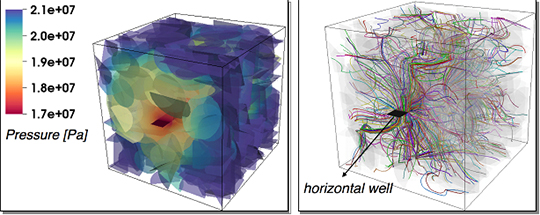
Figure 6: (Left panel): Results from a reservoir-scale modeling approach to obtain production curves through fracture drainage. The figure shows pressure solution in the discrete fracture network. A network of 376 natural fractures based on data from the upper Pottsville formation (Alabama) is generated in a domain of size 200 x 200 x 200 m. A horizontal well is placed in the center of the domain. Six equally spaced fractures perpendicular to the horizontal well are created to represent hydraulically generated fractures. A pressure of 21 MPa is applied to the boundaries parallel to the horizontal well while a pressure of 17 MPa is maintained at the well. The simulation tracked 100,000 particles. Only 1,000 pathways are shown for visualization purposes. The pressure gradient between the boundaries and the well draws the gas packets towards the well. (Right panel): A selection of the particle trajectories. Physically, these particle exit times represent the initial fracture drainage out of the network.
Reference: “Shale Gas and Non-aqueous Fracturing Fluids: Opportunities and Challenges for Supercritical CO2,” Applied Energy 147, 500 (2015); doi:10.1016/j.apenergy.2015.03.023. Authors include: Richard Middleton, Jeffrey Hyman, Qinjun Kang, Satish Karra, and Hari Viswanathan (Computational Earth Science, EES-16); Bill Carey, Mark Porter, and Joaquín Jiménez-Martínez (Earth System Observations, EES-14); and Robert Currier (Physical Chemistry and Applied Spectroscopy, C-PCS).
The Laboratory Directed Research and Development (LDRD) program and DOE’s Unconventional Fossil Energy Program managed by the National Energy Technology Laboratory’s Strategic Center for Natural Gas and Oil funded different aspects of the work. The research supports LANL’s Energy Security mission area and the Information, Science, and Technology and the Materials for the Future science pillars through the development of means to increase gas production and for carbon sequestration. Technical contact: Richard Middleton
Materials Physics and Applications
Computational and experimental approaches examine tuning of magnetic materials
Researchers used the unique 60-tesla long pulse and 100-tesla nondestructive magnets at the National High Magnetic Field Laboratory (NHMFL)-Pulsed Field Facility at Los Alamos to determine that magnetic field and pressure are alternative ways to tune the magnetic properties of the fascinating compound SrCu2(BO3)2, called (SCBO). The material is a low-dimension, quantum antiferromagnetic system with competing interactions. The journal Proceedings of the National Academy of Sciences of the United States of America published the findings.
The team developed an approach to quantify the effects that unavoidable lattice changes have in the exchange interactions of magnetic materials, an important factor when scientists are considering fundamental studies or applications of magnetic materials with competing interactions. Their novel approach combines pulsed field transversal and longitudinal optical fiber Bragg grating magnetostriction measurements using the NHMFL magnets to investigate the material’s physical dimensions, with Density Functional based calculations to pinpoint the driving force behind the magnetoelastic coupling. The high sensitivity of the new optical technique in pulsed magnetic fields (1 part in ten million) makes it possible to observe minute changes in the material, and the theory explains what is actually happening to the individual atoms. This method has broad implications beyond SCBO for making predictions for the highly magnetized states and the effects of applied pressure on materials.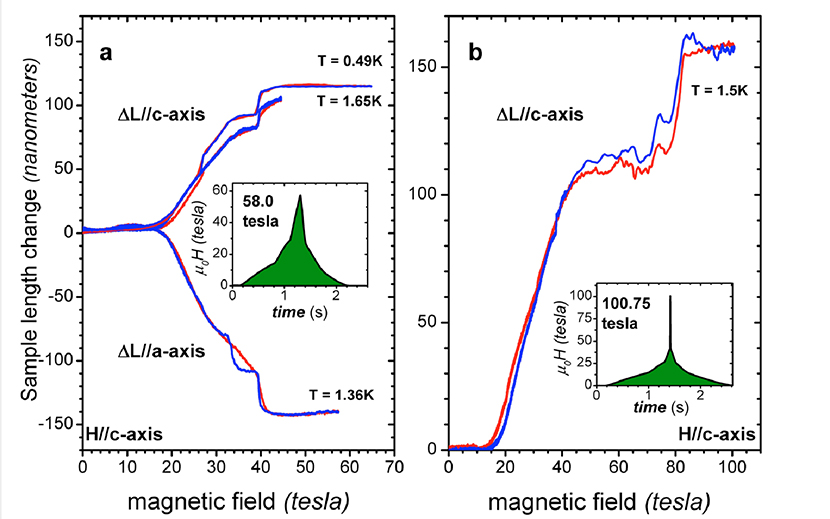
Figure 7. Length changes in SrCu2(BO2)3 obtained in 60-tesla (left) and 100-tesla (right) pulsed magnets at NHMFL. The sample length follows closely the field-induced magnetization in this strongly frustrated system.
The spins of the unpaired electrons in a solid tend to align along an applied magnetic field. In antiferromagnetic materials having competing interactions (called frustration), the magnetism can exhibit complicated structures with discreet jumps and plateaus in increasing applied magnetic fields. SCBO is one of these materials. Researchers found experimentally that its macroscopic physical dimensions also change with the magnetic field to mimic the behavior in the magnetization closely. Quantum mechanics demonstrated that minute deformations allow a significant reduction in the effective magnetic interactions responsible for the anti-ferromagnetism. The orthogonal arrangement of the magnetic copper (Cu2+) dimers acting as pantographs cause this phenomenon (Figure 8). The pantographs connect small size or linear dimension variations with large atomic bond angle variations. The pantographs enable the atoms to move without a high cost in elastic energy. Changes in the bond angle a cause concomitant changes in the magnetic interactions between copper atoms that are large enough to change the magnetic properties of the material.
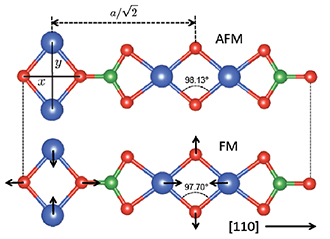
Figure 8. Schematic representation of the pantograph mechanism. It allows a modification of the Cu-O-Cu superexchange angle with a 50 times reduced effect on the lattice parameter. Oxygen atoms are in red, boron in green, and copper in blue. Arrows indicate the atom motion in the magnetically-polarized high field state.
Magnetoelastic coupling can be used to suppress the system’s spin-gap and tune magnetism either with magnetic fields or external pressures. The tuning “knob” discussed in this paper is the external magnetic field. Theory indicates that an identical effect could be achieved for SrCu2(BO3) by applying pressure. This is not always the case, because it often happens that a functionality enhanced by pressure is suppressed by magnetic fields (i.e. superconductivity). In SrCu2(BO3)2 both pressure and magnetic fields induce a reduction of the Cu-O-Cu bond angle that leads to the emergence of magnetism. This phenomenon enables tuning of the magnetic properties.
Reference: “Magnetic Nanopantograph in the SrCu2(BO3)2 Shastry-Sutherland Lattice,” Proceedings of the National Academy of Sciences of the United States of America 112, 1971 (2015); doi:10.1073/pnas.1421414112. Marcelo Jaime (Condensed Matter and Magnet Science, MPA-CMMS) and Myron Salamon (University of Texas at Dallas) authored the paper with researchers Guillaume Radtke (Sorbonne University and French National Museum of Natural History), Andrés Saúl (Aix-Marseille University in France and Massachusetts Institute of Technology), and Hanna A. Dabkowska (McMaster University).
The DOE Office of Science, Office of Basic Energy Sciences project Science at 100 Tesla, the National Science Foundation, the State of Florida, and the User Collaboration Grant Program at the National High Magnetic Field Laboratory funded the Los Alamos research. Understanding emergent phenomena in functional materials is aligned with grand challenges outlined by DOE’s Office of Science, Office of Basic Energy Sciences and the Lab’s Materials Strategy. The work supports the Lab’s Energy Security mission area and Materials for the Future science pillar by improving our understanding of magnetism and crystal structure correlations, and identifying effective ways to tune the functionality of materials externally. Technical contact: Marcelo Jaime
Materials Science and Technology
Discovery of surprisingly mobile defects in face-centered cubic metals
Two Los Alamos researchers have shed light on discrepancies in the understanding of irradiated materials where, at temperatures above 500 K, only large voids are observed. These new insights into defect structures and their properties help interpret experimental observations that have not been explained previously and could enable improved behavioral predictions of materials in extreme environments. The journal Scientific Reports published the results.
The formation of stacking fault tetrahedra (SFTs) is a primary problem in structural face-centered cubic (fcc) metals because their presence dramatically modifies both the mechanical properties of the specimen and the evolution of the material under extreme environments. SFTs can be produced from heavy plastic deformation or quenching from temperatures close to the material’s melting point. SFTs are ubiquitous in materials under irradiation for medical, space, or energy generation applications. Irradiation-created vacancies agglomerate and collapse to create more stable SFT defects. SFTs present an obstacle for dislocation motion, which causes hardening, embrittlement, and plastic instabilities. Previous research has examined the basic mechanisms that take place in the interaction of dislocations and SFTs. Understanding the evolution of such defects, especially growth mechanisms, is critical for predictive models of both the evolution and subsequent properties of materials subjected to plastic deformation and irradiation. Current theory assumes that these defects are static objects after creation.
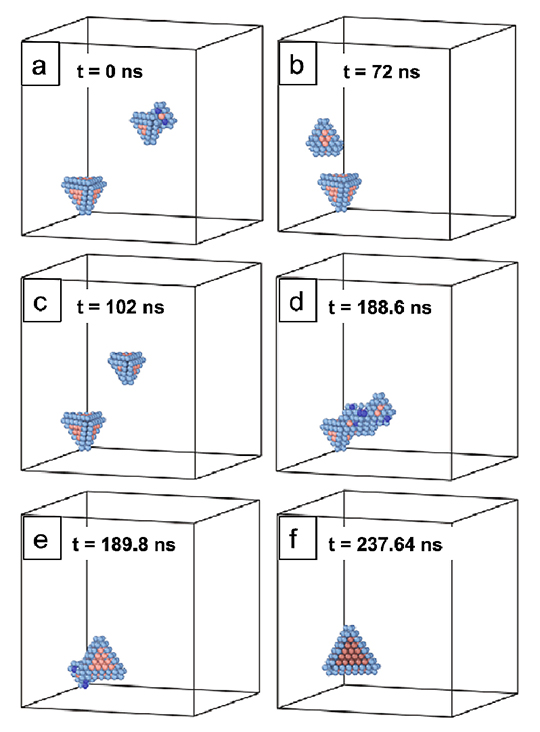
The Los Alamos researchers used molecular dynamics (MD) and temperature accelerated dynamics (TAD) simulations to study a simple metal, fcc copper. The scientists demonstrated that SFTs could exhibit extremely high mobilities, in some cases higher than point defects. This result is counter to conventional wisdom. The large mobility of defected SFTs provides a possible explanation for the dearth of small SFTs at the high temperature regime (above 500 K) observed experimentally. SFTs diffuse by temporarily disrupting their structure through activated thermal events. The researchers’ work revealed that the diffusivity of defective SFTs is several orders of magnitude higher than are perfect SFTs, on the order of or even surpassing the mobility of single vacancies. This is the first demonstration that large vacancy clusters in any material have higher mobility than point defects.
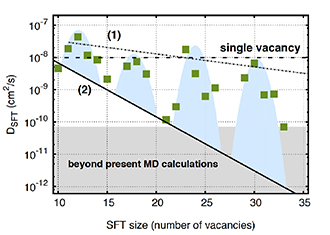
Figure 10. Diffusion coefficient at 700 K of several SFT configurations, depending on the number of vacancies composing the defect. The green dots show the molecular dynamic results and the light blue shade is a fit to the data. The maximum diffusivity of defective SFTs (1) and the minimum diffusivity of perfect SFTs (2) have also been fitted. The diffusivity of a single vacancy is also shown for comparison. MD is molecular dynamics.
This study proposes a new growth mechanism for SFTs by which small SFTs interact with one another to form larger SFTs. This research demonstrates that SFT mobility itself might be a critical mass transfer mechanism in the evolution of cold-worked or radiation-damaged materials that must be accounted for in larger scale models to make accurate predictions of materials behavior.
Reference: “Mobility and Coalescence of Stacking Fault Tetrahedra in Cu,” Scientific Reports 5, 9084 (2015); doi: 10.1038/srep09084. Authors: Enrique Martinez and Blas Uberuaga (Materials Science in Radiation and Dynamic Extremes, MST-8).
The DOE funded the work through the Laboratory Directed Research and Development (LDRD) program, and the research used resources provided by the Los Alamos National Laboratory Institutional Computing Program, which DOE NNSA supports. The work supports the Laboratory’s Energy Security mission area and Materials for the Future science pillar through insights to aid in predicting and designing materials for improved performance and enabling cost savings for nuclear energy production. Technical contact: Enrique Martinez Saez
Physics
Illuminating the origin of the nucleon spin
Los Alamos researchers are leading a new experiment at Fermi National Accelerator Laboratory addressing one of the most vexing puzzles in nuclear physics and quantum chromodynamics: the origin of the nucleon spin, a fundamental quantity. LANL completed testing a 5-tesla superconducting magnet that will enable this experiment, an important milestone in the Laboratory Directed Research and Development (LDRD) Directed Research-funded project that enables Los Alamos to finish the polarized system on time.
Nucleons (protons and neutrons) are composed of quarks and gluons, the elementary particles of the strong interaction. Experimental evidence indicates that the sum of the quark and gluon intrinsic angular momenta only contributes approximately 1/3 of the total proton spin. Thus, the majority of the proton spin is unaccounted for, which has been referred to as the “proton spin crisis”. The missing fraction of the spin is likely carried by the orbital angular momentum of the quarks and gluons. The long-term goal of this project is to develop the experimental capability to measure the spin of the proton from contributions of the spins of the quarks, gluons, and their orbital angular momentum. The research seeks to understand the relative significance of these spin contributions in the theory of strong interactions, Quantum Chromodynamics (QCD), and how they manifest themselves in reactions with polarized proton beams and/or targets.
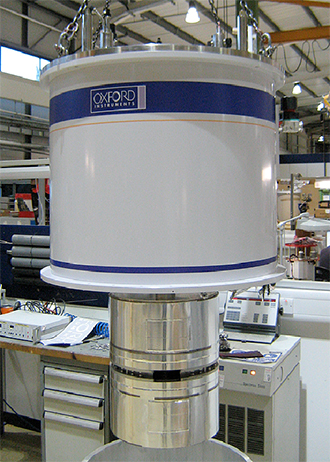
Photo. (Left): The magnet assembly, with the superconducting coils in the new orientation. The beam entrance hole is visible in the center.
In a naïve parton model, researchers had believed that the nucleon spin was the angular momentum coupling of the three quark spins. However, measurements over the past 20 years have shown that this contribution accounts for only about 30% of the total spin. Recent experiments from the Relativistic Heavy Ion Collider at Brookhaven National Laboratory point to a further contribution to the spin of 10-20% from the gluon spin. This contribution still leaves unaccounted roughly 50% of the total spin, a serious shortcoming in understanding the underlying theory of quantum chromodynamics, which seeks to explain the interaction of quarks and gluons, the basic building blocks of matter. The most likely explanation is the contribution of the angular momentum from the quarks, specifically the sea quarks.
This new experiment at the Fermi Lab aims to measure the angular momentum of the sea quarks via the Drell Yan process on a transversely polarized nucleon, where the polarization vector direction is perpendicular to the beam direction. Xiaodong Jiang, Andi Klein, David Kleinjan, Pat McGaughey, Ming Liu, Kun Liu, and Jackie Mirabal-Martinez (Subatomic Physics, P-25); Larry Rodriguez (Neutron Science and Technology, P-23) are lead experimenters. Klein and Ivan Vitev (Nuclear and Particle Physics, Astrophysics and Cosmology, T-2) are Principal Investigators.
To have such a polarized nucleon, Los Alamos scientists are building a transversely polarized target, which includes a 5-tesla superconducting magnet. A new magnet would cost roughly $700,000 and require about two years to build. LANL identified a suitable magnet that was in storage after use in a 1992 experiment in a polarized target system. Initial tests revealed that the magnet was still in excellent condition and could reach the design field of 5-tesla. Los Alamos shipped it to the original manufacturer, Oxford Instruments (United Kingdom) for refurbishing. The most critical change was reorienting the superconducting coils through a 90o rotation, necessary because the original polarization direction was longitudinal, i.e., parallel to the beam. The new experiment requires transverse polarization. This change required Oxford Instruments to separate the coils from the helium tank, rotate, and reconnect them.
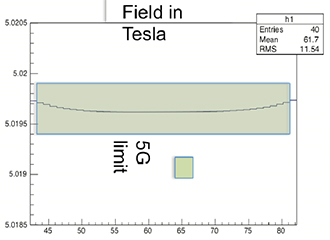
Figure 11. The field distribution inside the coil over 40 mm. The green band indicates the allowed homogeneity region of 5G.
Homogeneity of the field over the target volume is the most crucial quantity in such a magnet. The total field variation at any point in the target must be smaller than 5 gauss (G) in a field of 50,000G. Klein performed acceptance tests at Oxford Instruments due to the magnet’s substantially changed geometry. The work involved powering the magnet to its full 5-tesla design field, putting it into persistence mode, and measuring the field over the target volume. The magnet performed flawlessly to reach the full field after one initial quench. After optimizing the field with three shim coils, Klein measured the homogeneity over the whole target volume with a nuclear magnetic resonance probe. Figure 11 depicts a typical field distribution, where the green band indicates the 5G limit.
The fundamental research, which is part of the Laboratory’s scientific grand challenge of exploring physics beyond the standard model, supports the Laboratory’s Global Security mission area and Nuclear and Particle Futures science pillar by attracting and retaining scientists with the expertise required to contribute to national security science. Technical contact: Andi Klein
Science on the Roadmap to MaRIE
Neutron surface scattering studies important aspects of actinide surface chemistry
Actinides and actinide oxides exhibit some of the most intriguing and challenging chemistry known. Frequently their compositions are not stoichiometrically precise, and their oxide structures can change dramatically under various environmental conditions. Studies of actinide surfaces and surface-initiated chemical evolution of bulk materials are even more demanding. The scientific challenge is to identify, measure, and understand the aspects of their surface chemistry – which can depend on preparation methodology and aging conditions – without disturbing their microstructures. For example, the details of chemical evolution on plutonium-239 (239Pu) surfaces, particularly the Pu valence state, are important for understanding stockpile aging, due to the reversible auto-reduction of PuO2 to Pu2O3 under various environments. The other key science question involves reactivity of different actinides with gases and liquids at the atomic and nanoscales.
Data generated using the ASTERIX and SPEAR neutron spectrometers at the Lujan Center in the Los Alamos Neutron Science Center (LANSCE) represent the first measurement of plutonium oxide (PuOx), uranium oxide (UOx), and thorium (Th) films using neutron reflectometry. The results indicate that neutron surface scattering techniques (with reflectometry, grazing incidence diffraction, and grazing incidence small angle scattering) could give unique insight into these important systems from sub-nm to μm length scales. Such studies of actinides surface chemistry and reactivity are relevant to a broad spectrum of problems from environmental remediation to stockpile stewardship.
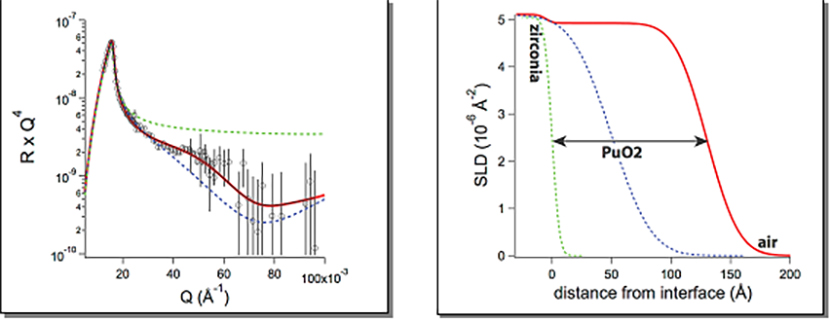
Figure 12. (Left): PuOx neutron reflectometry data (symbols with error bars) and fits (lines) corresponding to scattering length density models presented at the right graph. Green and blue depict pure zirconia interfaces with different roughness values. Inclusion of the PuO2 layer (red) was essential to fit the data.
Neutrons provide a distinct advantage compared with x-rays in structural characterization of lighter elements and accessibility of buried interfaces. This advantage making them an excellent probe for studying and mapping different hydride and oxide forms at surfaces and interfaces of heavy metals. Neutrons have excellent penetrability and comparable scattering cross sections for actinides and isotopes of interest (molecular oxygen, hydrogen, and deuterium). These characteristics are ideally suited to study Ångström (Å, 10-10 m) length scales changes in the chemistry of these materials.
The team conducted preliminary studies of neutron reflectometry of 239PuOx , UOx and Th thin films at LANSCE using ASTERIX and SPEAR. They used polymer-assisted deposition to grow nanometer-thick films of PuOx on a zirconia substrate with approximately 1 cm2 surface area (total mass of PuOx less than 50 micrograms). DC-magnetron sputtering prepared the films of UOx and Th. The researchers used neutron reflectometry and off-specular neutron scattering to determine the thickness and composition of the films.
The preliminary neutron scattering data of the PuOx film quantified the characteristics of a high quality film (Figure 12), The scattering length density (SLD) distribution normal to the surface is homogenous and matches almost exactly the literature value for crystalline 239PuO2. The team did not observe a lower density region between PuO2 and zirconia substrate or other chemically different layer at the air interface. The researchers detected the air/PuO2 and zirconia/chemically different layer at the air interface. The air/PuO2 and zirconia/PuO2 roughness were approximately 20 and 5 Å root mean square, respectively. Very small off-specular scattering indicates a high degree of in-plane order within the film.
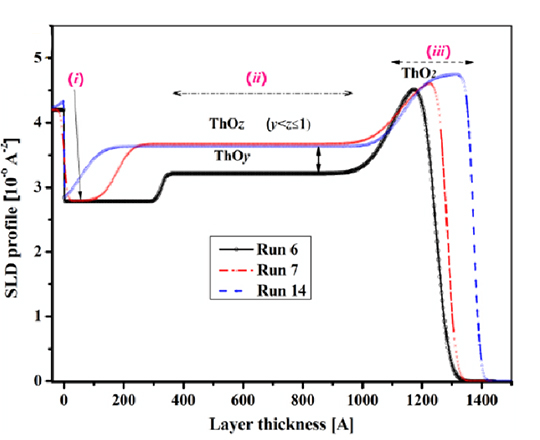
Figure 13. Scattering length density (SLD) distributions obtained from neutron reflectometry measurements correspond to various stages of controlled oxidation of Th film. Approximately 1200 Å thick Th layer was deposited on -quartz, exposed to ~100 ppm O2 in Ar at 150°C and investigated using neutron scattering in-situ. Runs 6, 7 and 14 represent approximately 300, 350 and 700 minutes of O2 exposure, respectively. The zero thickness is set at the quartz substrate/Th film interface. SLD profiles illustrate continuous growth of both ThO2 and ThOz regions with simultaneous swelling of the film. The final stage of oxidation corresponds with formation of ThO layer between the quartz substrate and ThO2 capping layer.
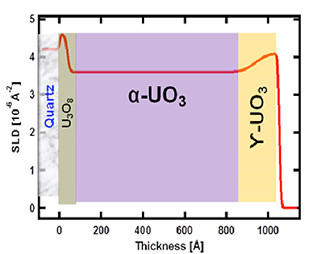
Figure 14. The scattering length density (SLD) distributions obtained from neutron reflectometry measurements of a uranium oxide film. Neutron reflectometry revealed that the film was composed of three distinctive sub-layers: (i) a film of α-U3O8 along the substrate interface, (ii) α-UO3 (a uranium-deficient form of α-U3O8 with a large concentration of vacancies) and (iii) the top, atmosphere-exposed and thermodynamically most stable phase, of γ-UO3.
Neutron reflectometry determined the chemical speciation signatures of a complex uranium oxide family. The method characterized both the surface and underlying layers of the uranium oxides with Å-level-resolution. This capacity cannot be achieved using x-ray scattering because it is not capable of distinguishing between U3O8 and α-U3O8 , especially at the nanometer scale. The Å-resolution measurement of the chemical speciation and its spatial distribution for nuclear materials of technological importance could foster a revolution in understanding their oxidative behavior by providing new capabilities to exploit rich forensic information and extend fundamental knowledge to assess or interpret the signatures, while leaving the opportunity to employ additional, possibly destructive methods of analysis. The development of this method may also be applicable to a broad range of other scientific disciplines.
The work is an example of Science on the Roadmap to MaRIE, the Lab’s proposed experimental facility for control of time-dependent material performance. The combination of x-ray and neutron surface scattering methods at MaRIE could provide unprecedented, time-resolved access to structural properties of actinides and their surfaces from atomic- to meso- scales. A complete picture of the chemical depth profiles and surface topography of hydrides and oxides formed at metal interfaces would be provided. The highly penetrative nature of neutrons together with high energy x-rays could facilitate these studies over a wide range of chemical environments, pressures, and temperatures.
Researchers include Daniel Schwartz, David Moore, and Joe Martz (Nuclear Materials Science, MST-16); Brian Scott, Eve Bauer, and Erik Watkins (Materials Synthesis and Integrated Devices, MPA-11); Ann Junghans (Polymers and Coatings, MST-7); Peng Wang (formerly Lujan Center, LC-LANSCE); Kirk Rector and Heming He (Physical Chemistry and Applied Spectroscopy, C-PCS); David Allred (Brigham Young University); and Jarek Majewski (Center for Integrated Nanotechnologies, MPA-CINT).
The NNSA Primary Assessment Technologies Campaign, Laboratory Directed Research and Development (LDRD), and a G. T. Seaborg Institute postdoctoral fellowship sponsored different aspects of the research. This work benefited from the use of the time-of-flight neutron reflectometer SPEAR and ASTERIX at LANSCE’s Lujan Center, which the DOE Office of Basic Energy Sciences previously funded. The work supports the Lab’s Nuclear Deterrence and Energy Security mission areas and the Science of Signatures science pillar. Technical contact: Jarek Majewski











